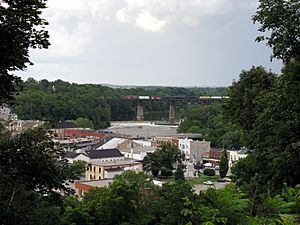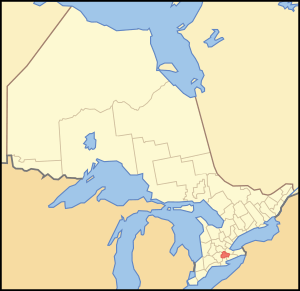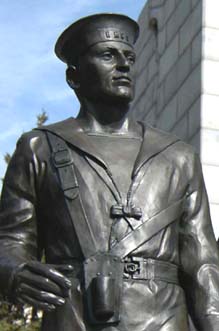County of Brant facts for kids
Quick facts for kids
Brant
|
|
|---|---|
| County of Brant | |

Paris, Ontario
|
|
| Motto(s):
Simply Grand
|
|
 |
|
| Country | Canada |
| Province | Ontario |
| Settled | 1793 |
| Formed | 1851 (county) |
| Formed | 1999 (single-tier city) |
| Seat | Burford |
| Area | |
| • Land | 817.66 km2 (315.70 sq mi) |
| Population
(2021)
|
|
| • Total | 39,474 |
| • Density | 48.3/km2 (125/sq mi) |
| Time zone | UTC-5 (EST) |
| • Summer (DST) | UTC-4 (EDT) |
| Postal Code |
N0E, N3L
|
| Area code(s) | 519, 226, and 548 |
| Website | www.brant.ca |
The County of Brant is a special kind of city in Ontario, Canada. Even though its name has "County," it works like a single city government. It's not part of a bigger county system. In 2021, about 39,474 people lived here.
You can find offices for the County of Brant in places like Burford, Paris, Oakland, Onondaga, and St. George. The biggest town in the County is Paris, with almost 15,000 people.
Brant is mostly a rural area in Southern Ontario. It's surrounded by other towns and cities. The City of Brantford is right next to the County of Brant, but it's a separate city with its own government. The wider Brant area, including Brantford and nearby Indigenous lands, had over 144,000 people in 2021.
The County is named after a famous Mohawk leader, Joseph Brant. It was officially created in 1851.
Contents
Brant's History
The area that became Brant County was once part of other counties. Brant County was formed in 1851. It included several townships:
- Brantford Township: This area included Brantford, Paris, and other smaller communities. It was first settled before 1810.
- Burford Township: This was one of the first areas to have settlers. Four families moved here before 1800.
- Oakland Township: This area became its own municipality in 1850.
- Onondaga Township: People started settling here in 1838.
- South Dumfries Township: This included Paris and St. George.
- Tuscarora Township: This was created in 1784 for Indigenous peoples.
On January 1, 1999, many of these smaller towns and townships joined together. They formed the new city officially called the County of Brant.
Early Days of Brant
There are many historical markers in Brant County. They tell stories about its long history, especially about the First Nations people.
After the American Revolution, the British Crown gave land along the Grand River to Joseph Brant and the Mohawk people. This was to make up for land they lost. In 1788, about 400 Mohawk people settled on the Grand River. This settlement later became Brantford.
The Mohawk Chapel was built in 1785 for the Mohawk and Iroquois people. It reminds everyone of the agreements made with the British. In 1904, King Edward VII gave it "Royal" status. This honored the long friendship between the Mohawk and the British. It's still used today and is one of Canada's oldest Protestant churches. Joseph Brant and his son John Brant are buried there.
In 1793, a mineral called gypsum was found near the Grand River. This area later became Paris. By 1794, a road was built connecting Paris to Dundas, Ontario. By 1846, Paris was a busy community of 1,000 people. Many factories and mills were powered by the river. The village of Paris became an official town in 1856.
Settlers also arrived in Burford Township around 1797. During the War of 1812, a battle happened in what is now Oakland. American forces attacked local soldiers there.
Chief John Brant (Mohawk leader), son of Joseph Brant, also fought in the War of 1812. He worked hard to help the First Nations people. He helped build schools and became the first Indigenous Superintendent of the Six Nations. In 1830, he was elected to the government, becoming the first Indigenous Canadian in Parliament.
By 1846, the small town of Scotland had about 150 people. It had stores, taverns, and various trades. Nearby Oakland had about 160 people and its own businesses.
More people moved to the County in the 1820s and later when navigation to Brantford opened. The railway also arrived in 1854. The Brant County Courthouse was built in 1852. It held courtrooms, offices, and a jail.
Chiefswood, a National Historic Site, was built around 1856. It was the home of Mohawk Chief George Henry Martin Johnson. His daughter, E. Pauline Johnson, became a famous poet. Her poems helped people learn about First Nations history and culture.
Railways in Brant
Brant County was important for early railway development in Ontario. It was located between big cities like Toronto and London. Plans for railways started in the 1830s.
The Great Western Railway opened its main line in 1853. A branch line to Galt was finished in 1854. This branch line connected to the main line at a key spot in Brant County. This spot was between Brantford, Galt, Hamilton, and London.
A town grew around this railway junction. It was named Harrisburg. Some historians believe Harrisburg was Canada's first railway junction. They also think the branch line to Galt was the first branch line in Canadian railway history. Another railway line to Brantford was built in 1871.
Invention of the Telephone
Alexander Graham Bell invented the telephone at his father's home. This home, called Melville House, is now the Bell Homestead National Historic Site. At the time, it was in the County of Brant, just outside Brantford. Bell once said, "the telephone problem was solved, and it was solved at my father's home."
Some of the first successful long-distance phone calls happened in August 1876. They were made between Brantford, Melville House, and Paris. Canada's first telephone factory was also in Brantford. It was started by James Cowherd around 1879. The first telephone business office opened in 1877, also in the County of Brant.
Brant's Geography
Communities in Brant
Besides Brantford, the main towns in Brant are Paris, St. George, and Burford. There are also many smaller communities. These include Cainsville, Glen Morris, Harrisburg, Mount Pleasant, and Scotland.
Climate in Brant
Brant County has a climate with warm summers and cold winters. The average temperature in January is around -5.4°C (22.3°F). In July, the average temperature is about 21.5°C (70.7°F). The area gets a good amount of rain and snow throughout the year.
People of Brant
In 2021, the County of Brant had a population of 39,474 people. This was a 10.8% increase from 2016. The County is about 817.66 square kilometers in size. This means there are about 48.3 people living in each square kilometer.
The people living in Brant County come from many different backgrounds. Most residents are of European heritage. There are also many people from Indigenous, South Asian, African, and other backgrounds. This mix of cultures makes Brant a diverse place to live.
Local Groups
Many local groups help the community in Brant. The Kinsmen Club of Brantford is a non-profit group. They help raise money for local charities. They organize fun events like the Brantford Kinsmen Annual Car Show in Paris and the Brantford Kinsmen Annual Ribfest in Brantford.
The County of Brant Public Library serves all the communities in the County. It has five branches in Paris, Burford, Scotland, St. George, and Glen Morris. The main library in Paris was built with money from Andrew Carnegie in 1902.
Album of Honour
The Album of Honour for Brant County is a special book. It was put together in 1946 by the Kinsmen Club of Brantford. The book remembers all the men and women from Brantford, the County of Brant, and the Six Nations who served in World War II. It lists over 3,500 names and includes many photographs. You can find this book in the Digital Archives of the Brantford Public Library.
Images for kids
See also
 In Spanish: Brant para niños
In Spanish: Brant para niños





